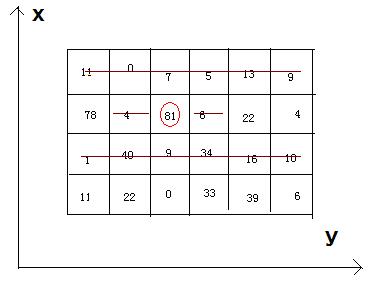Beans(dp,两次dp)
2016-05-10 17:41
288 查看
Beans
Time Limit: 2000/1000 MS (Java/Others) Memory Limit: 32768/32768 K (Java/Others) Total Submission(s): 4141 Accepted Submission(s): 1964[align=left]Problem Description[/align]
Bean-eating is an interesting game, everyone owns an M*N matrix, which is filled with different qualities beans. Meantime, there is only one bean in any 1*1 grid. Now you want to eat the beans and collect the qualities, but everyone must obey by the following rules: if you eat the bean at the coordinate(x, y), you can’t eat the beans anyway at the coordinates listed (if exiting): (x, y-1), (x, y+1), and the both rows whose abscissas are x-1 and x+1.

Now, how much qualities can you eat and then get ?
[align=left]Input[/align]
There are a few cases. In each case, there are two integer M (row number) and N (column number). The next M lines each contain N integers, representing the qualities of the beans. We can make sure that the quality of bean isn't beyond 1000, and 1<=M*N<=200000.
[align=left]Output[/align]
For each case, you just output the MAX qualities you can eat and then get.
[align=left]Sample Input[/align]
4 6
11 0 7 5 13 9
78 4 81 6 22 4
1 40 9 34 16 10
11 22 0 33 39 6
[align=left]Sample Output[/align]
242
题解:一次对行dp,一次对列dp;
java超时了。。。c就不会
代码:
import java.util.Scanner;
public class Beans {
static int a[] = new int[200010], dp[] = new int[200010], DP[] = new int[200010], b[] = new int[200010];
public static void main(String[] argvs){
int M, N;
Scanner cin = new Scanner(System.in);
while(cin.hasNext()){
M = cin.nextInt();
N = cin.nextInt();
for(int i = 0; i < M; i++){
DP[i] = 0;
for(int j = 0; j < N; j++){
dp[j] = 0;
a[j] = cin.nextInt();
if(j < 2)
dp[j] = a[j];
else
dp[j] = Math.max(dp[j - 2] + a[j], dp[j - 1]);
}
DP[i] = dp[N - 1];
if(i < 2)
b[i] = DP[i];
else
b[i] = Math.max(b[i - 2] + DP[i], b[i - 1]);
}
System.out.println(b[M - 1]);
}
}
}
相关文章推荐
- Kafka设计解析(五)- Kafka性能测试方法及Benchmark报告
- Python连接oracle数据库踩到的坑
- Kafka设计解析(四)- Kafka Consumer设计解析
- 杭电 2034
- IDEA下web项目的搭建
- Android 中文api,Debug签名证书过期(Expiry of the Debug Certificate)
- OJDBC版本区别 [ojdbc14.jar,ojdbc5.jar和ojdbc6.jar的区别]
- 触摸屏 触摸操作 鼠标点击事件
- 对系统日历CalendarProvider进行增删改查操作的测试
- hdu1399Starship Hakodate-maru
- Spark内核架构
- Spring方法注入
- go and vim-go
- adb常用命令介绍
- adb常用命令介绍
- android: 使用 IntentService
- Android图片资源
- Kafka设计解析(三)- Kafka High Availability (下)
- JavaScript根据CSS的Media Queries来判断浏览设备的方法
- Kafka设计解析(二)- Kafka High Availability (上)
